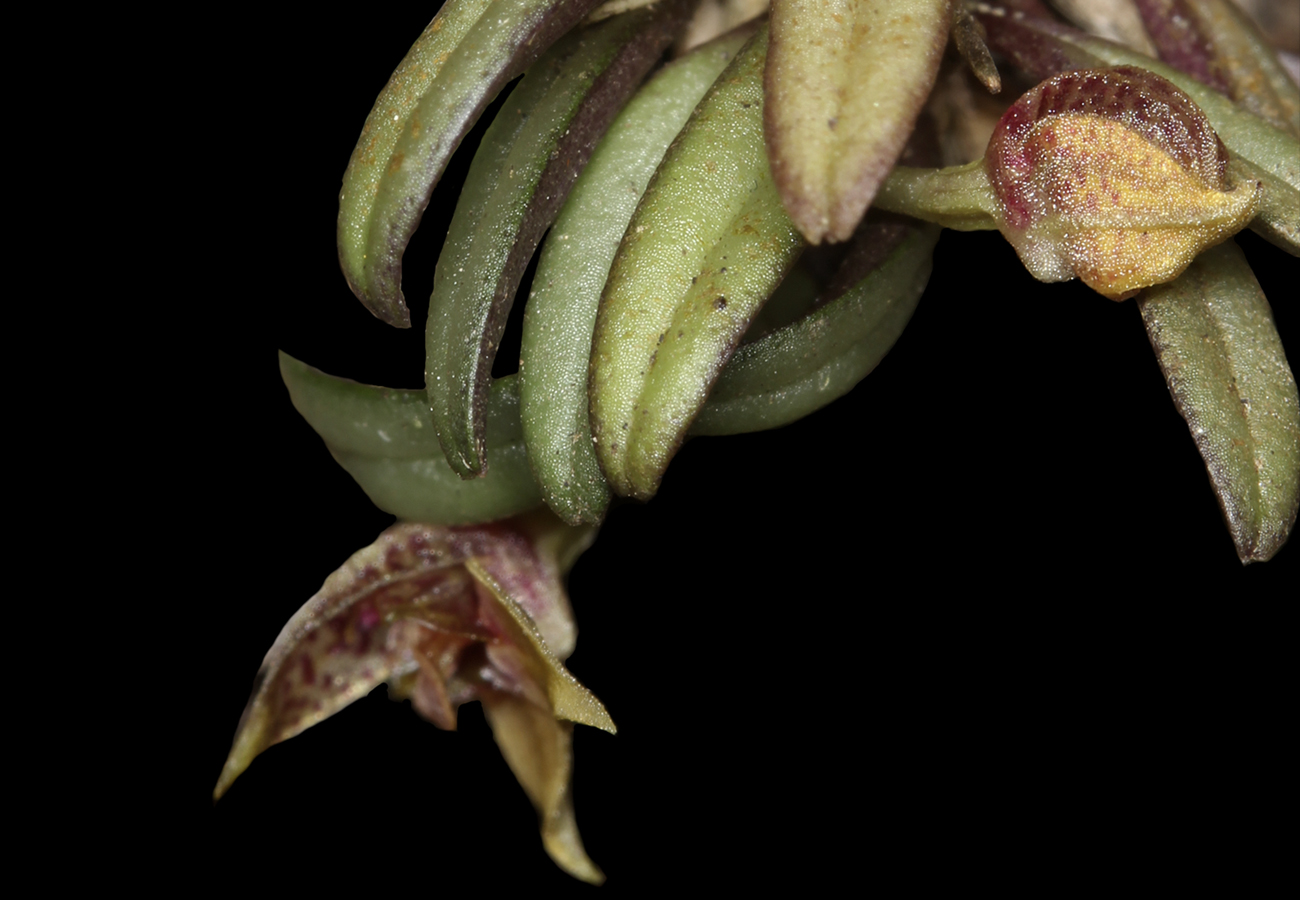Abstract
Dryadella catharinensis, a new orchid species found in the north-northeast part of the Santa Catarina state, in southern Brazil, is described here. The tiny new species was found in the dense ombrophilous submontane forest (Floresta Ombrófila Densa Submontana) in the Atlantic Rainforest. It is similar to Dryadella susanae, which is endemic of the Espírito Santo state and differs in the larger vegetative size, the narrow and suberect leaf, yellow flowers, the sepals with slightly denticulate margins, the petals with an obtuse apex and the cuneate lip with denticulated margins and a annular callus in the median portion of the claw. It is the fifteenth Dryadella species restricted to the Atlantic Rainforest (~25% of the genus), evidencing the importance of the conservation of this biome—of which only 11% remains—for the genus. Due to the rarity and low density of this species in the field, allied to the degradation of the habitat, we suggest a conservation status of Endangered. Further fieldwork is needed to locate additional populations and study the biological aspects for their conservation.
References
<p>BFG (The Brazil Flora Group) (2015) Growing knowledge: an overview of Seed plants diversity in Brazil. <em>Rodriguésia </em>66: 1085–1113. https://doi.org/10.1590/2175-7860201566411</p>
<p>BFG (The Brazil Flora Group) (2018) Brazilian Flora 2020: Innovation and collaboration to meet Target 1 of the Global Strategy for Plant Conservation (GSPC). <em>Rodriguésia</em> 69: 1513–1527.https://doi.org/10.1590/2175-7860201869402</p>
<p>Braga, P.I.S. (1978) Estudos da Flora Orquidológica do Estado do Amazonas. II- <em>Masdevallia osmariniana</em> Braga (Orchidaceae), espécie nova da Flora Amazônica. <em>Acta Amazonica </em>3 (7): 333–334.https://doi.org/10.1590/1809-43921977073333</p>
<p>Castro, V.P., Faria, B.P. & Santana, A.D. (2004) Première occurrence du genre <em>Dryadella</em> Luer (Orchidaceae), dans le centre-ouest du Brésil. <em>Richardiana</em> 4 (4): 198.</p>
<p>Cogniaux, C.A. (1906) <em>Masdevallia edwallii </em>Cogn., <em>Masdevallia lilliputiana</em> Cogn. <em>In: </em>Martius, C.F. (Ed.) <em>Flora Brasiliensis, enumeratio plantarum in Brasilia hactenus detectarum </em>3 (6): 554–555.</p>
<p>CRIA (2016) Centro de Referência e Informação Ambiental. Specieslink - simple search. Available from: http://www.splink.org.br/index (accessed 3 January 2021)</p>
<p>Fidalgo, O. & Bononi, V.L.R. (1989) <em>Técnicas de coleta, preservação e herborização de material botânico</em>. Reimpressão. Instituto de Botânica, São Paulo, 62 pp.</p>
<p>Dunsterville, G.C.K. & Garay, L.A. (1979) <em>Orchids of Venezuela: An Illustrated Field Guide</em>, London, 3: 172. il.</p>
<p>Imig, D.C., Fraga, C.N. & Smidt, E.C. (2020) <em>Dryadella</em>. <em>In:</em> Flora do Brasil 2020. Jardim Botânico do Rio de Janeiro. Available from: http://floradobrasil.jbrj.gov.br/reflora/floradobrasil/FB11471 (accessed 27 February 2021)</p>
<p>IUCN Standards and Petitions Committee (2019) Guidelines for Using the IUCN Red List Categories and Criteria. Version 14. Prepared by the Standards and Petitions Committee. Available from: http://www.iucnredlist.org/documents/RedListGuidelines.pdf. (accessed 17 February 2021)</p>
<p>Mancinelli, W.S. & Esemann-Quadros, K. (2016) Orchidaceae Flora of Joinville, Santa Catarina, Brazil. A<em>cta Biológica Catarinense</em> 3 (1): 36–48. https://doi.org/10.21726/abc.v3i1.231</p>
<p>Luer, C.A. (1978) <em>Dryadella</em>, a new genus in the Pleurothallidinae (Orchidaceae). <em>Selbyana</em> 2: 207–209.</p>
<p>Luer, C.A. (2005) Icones Pleurothallidinarum XXVII. <em>Dryadella</em> and <em>Acronia</em> sect. <em>Macrophyllaceae-Fasciculatae. Monographs in Systematic Botany from the Missouri Botanical Garden </em>103: 1–55.</p>
<p>Pabst, G.F.J. & Dungs, F. (1975) Orchidaceae Brasilienses I, Kurt Schmersow, Hildesheim, 408 pp.</p>
<p>Pabst, G.F.J. (1976) Additamenta ad Orchideologiam Brasi-liensem. <em>Dryadella susanae </em>sp nova. Pabst. <em>Bradea</em> 2: 68.</p>
<p>Peres, E.A., Pinto-da-Rocha, R., Lohmann, L.G., Michelangeli, F.A., Miyaki, C.Y. & Carnaval, A.C. (2020) Patterns of Species and Lineage Diversity in the Atlantic Rainforest of Brazil. <em>In:</em> Rull, V. & Carnaval, A.C. (Eds.) <em>Neotropical Diversification: Patterns and Processes. Fascinating Life Sciences</em>. Springer, Cham, pp. 415–447. https://doi.org/10.1007/978-3-030-31167-4_18</p>
<p>Porsch, O. (1905) <em>Masdevallia zebrina</em> Porsch. <em>In:</em> <em>Oesterreichische Botanische Zeitschrift</em> 55: 154.https://doi.org/10.1007/BF01786777</p>
<p>POWO (2020) Plants of the World Online. Facilitated by the Royal Botanic Gardens, Kew. P. Available from: http://www.plantsoftheworldonline.org (accessed 17 February 2021)</p>
<p>Pridgeon, A.M. (2005) Subtribe Pleurothallidinae. <em>In:</em> Pridgeon, A.M., Cribb, P.J., Chase, M.W. & Rasmussen, F.N. (Eds.) <em>Genera Orchidacearum</em>. <em>Volume 4 Epidendroideae (Part One)</em>. Oxford University Press, Oxford, pp. 405–412.</p>
<p>Reichenbach, H.G. (1871) <em>Pleurothallis aviceps</em>. <em>The Gardeners’ Chronicle & Agricultural Gazette</em> 2: 1579.</p>
<p>Reginato, M. & Michelangeli, F.A. (2020) Bioregions of eastern Brazil, based on vascular plant occurrence data. <em>In:</em> Rull, V. & Carnaval, A.C. (Eds.) <em>Neotropical Diversification: Patterns and Processes. Fascinating Life Sciences</em>. Springer, Cham, pp. 475–494. https://doi.org/10.1007/978-3-030-31167-4_18</p>
<p>Stearn, W.T. (2004) <em>Botanical Latin</em>. 4th ed. David & Charles, London, 546 pp.</p>
<p>Thiers, B. (2020) Index Herbariorum. Part I: The herbaria of the world. New York Botanical Garden. Available from: https://www.sweetgum.nybg.org/ih (accessed 23 December 2020)</p>
<p>Vibrans, A.C., Bonnet, A., Caglioni, E., de Gasper, A. & Lingner, D.V. (2013) Epífitos vasculares da Floresta Ombrófila Densa de Santa Catarina. <em>In:</em> Vibrans, A.C., Sevegnani, L., Gasper, A.L. & Lingner, D.V. (Eds.) <em>Inventário Florístico de Santa Catarina</em>, Blumenau, Edifurb 5, p. 58.</p>


